For far too much of my life, I avoided activities I saw as overly feminine. I was no tomboy—that requires a base of athleticism I didn’t have—but, as an intellectually-inclined child, I let my bedroom get messy, never moved beyond boiling water in my kitchen skills, eschewed crafting, and never bothered with beauty routines.
I was wrong. I wasn’t naturally interested in those things, sure, and that’s fine, but I also disdained them for being too “girly,” internalizing our culture’s devaluation of the traditionally feminine. Some might think this is ironic, but it was only my deepened involvement in feminism, which helped me recognize and articulate this internalized misogyny in myself, that gave me permission to embrace traditionally feminine activities like crafting.
I haven’t embraced all the feminine arts; I don’t really cook (my husband does that much better than me), and I still don’t wear makeup (in the past 15 years, I’ve worn makeup only twice: to my senior prom, and to my wedding), and I still don’t keep a clean house (I thought the mold in our shower was just how it’s supposed to look), but I’ve come around on crafting. Too often crafting, especially female crafting, is dismissed as pointless drudgery, or a waste of time, or just plain unimportant. But this perspective, like so many others that dismiss the feminine types of creation, misses the true value of crafts.
I’m still not the right person for a passionate screed on the true value of all crafting, but in the past few years I’ve shifted my perspective as I’ve taken up a hobby that would make my teenage self recoil in embarrassed horror: quilting. Yes, quilting, that domain of Little House In the Big Woods and your great-grandma. And I’m here to say that I’m a better person for quilting, and you should try it too.
1. Be a creator, not a consumer.
I live at a distance from the material world: I don’t grow my own food or build my own house or make my own clothes or fetch my own water or chop my own firewood, and, as white-collar professional, the closest I get to creating a material thing is still just words on a page or bits on a computer screen somewhere. Most of my leisure time, meanwhile, is spent in consumption—shopping, eating out, watching TV, visiting Facebook, even reading books—and so quilting gives me a much-needed excuse to create something tactile, and it feels good. Elder Uchtdorf got this one right: happiness requires creation, not just consumption.
Hello creativity, goodbye anonymity.
2. Forgive yourself: small mistakes don’t matter in the big picture.
I make small mistakes on every quilt I create, and lots of them. When I’m up close and working on a quilt, the mistakes are all I can see: the block ever-so-slightly smaller than the one next to it, the colors that didn’t get distributed perfectly randomly, the seam that didn’t stay straight because I’m lazy about pressing (oops). By the time I’ve worked on a quilt for a few months, I’m fixated on the mistakes and hate my project. And yet, when I finish that last corner and look at the whole quilt from a distance, even I can’t see where I’ve messed up. In the big picture, mismatched edges or crooked seams are part of life, and part of the personality and beauty of a quilt, a testament to its handmade nature. The analogy to quilting eases my daily sweat about the small stuff: six months from now, will I remember this misplaced word in this email? A year from now, will I remember that offhand comment? Ten years from now, as I hold up the quilt of my life, will I see the small mistakes or only the overall pattern?
This is my sloppiest quilting. Can you tell?
3. Beauty comes from diversity.
The design of a quilt, and its appeal, comes from the balance of diverse fabrics, colors, and patterns, cut apart and put back together in a different order, stronger and more beautiful together. The analogy here is obvious. My life is better, and I am better, when I interact with others unlike myself: nationality, race, age, gender, religion, language, education level, disability—all are their own fabric patterns and colors, and finding the balance and harmony between them makes a life—and a city, and a state, and a country—more beautiful.
I, for one, think orange is beautiful.
4. Be patient.
At work, my impatience is one of my greatest strengths: with it, I push my team to faster and better performance, and I can rapidly switch between tasks and quickly think through complicated problems to form opinions. At quilting, though, impatience is a weakness to be corrected, as it only leads to mistakes. (See my point about being lazy with pressing.) It’s easy, sometimes, to fall into the trap of thinking of myself as being somehow too busy, or too important, or too good for slow manual work, and quilting is a needed reminder to slow down, to focus on using my hands instead of my mind, and that my patience will be rewarded in the end.
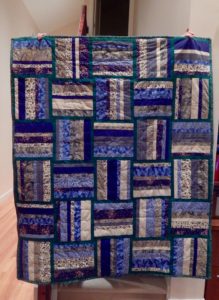
This took years. Good thing the recipients were patient too.
5. Work for love, not glory.
I specialize in baby quilts, mostly because I can quilt them on my home machine. Having no babies, I’ve given away every quilt I’ve made, including one recently that I gave to a stranger, a friend of my mother’s having her first child in a city far away from her own parents and family. Every quilt has been a labor of love and patience, but every quilt, if they’re used as intended, will ultimately be spit up on, pooped on, brushed against the grass or dirt, or simply fall apart through long use. I’m not creating precious art to be preserved in a museum: I’m creating objects for use, and the intention behind my work is pleasure and love, not glory. A single quilt won’t last, and won’t save the world, but it will, hopefully, tell someone that I love them and was thinking about them.
This baby was so wanted I started working on the quilt before she was conceived.
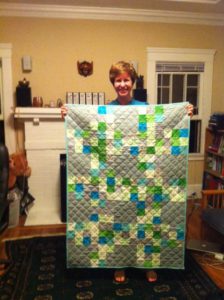
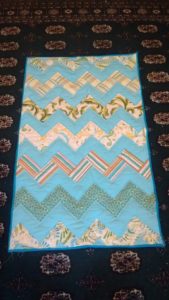
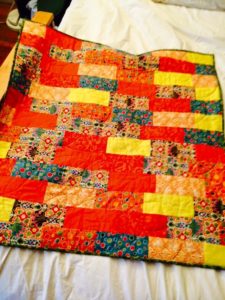
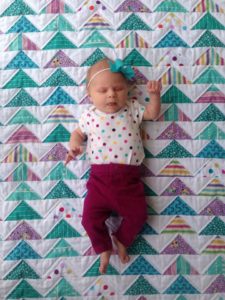
These are really cool, Petra! I love that you do this! Your lessons learned are really interesting too. I think the one that resonates with me most is to not sweat the small mistakes. That is totally an issue that I struggle with.
I grew up w a lot of internalized misogyny that my feminism helped me see for what it was, too. I try not to knock feminized things now that I’m aware (except the bachelor, I’m keeping that one on my list). I may not like ‘crafty’ crafting but I do like crocheting. And some of my greatest labors of love have been created from my own two hands. Your quilts are beautiful and I’m in awe bc I tried a baby quilt once and had zero patience for everything it requires. So. Much. Patience.